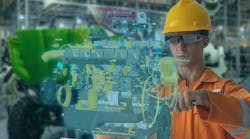Digital twins are rapidly becoming a business imperative for the next evolution of digital enterprises. By design, digital twins take advantage of the vast amounts of data from connected devices to provide a detailed, data-based model of a physical system. As the industrial internet of things (IIoT) connects more and more of these devices within organizations, virtual simulations of physical environments are becoming an increasingly critical piece of an enterprise digital strategy.
The capability is compounding with the vast processing power of high-performance computing (HPC), enabling diverse industries to apply digital twins to scale simulations, shorten development timeframes and derive tangible business results. “While digital twins are being looked at in the digital engineering realm for design and simulation work, there is significant untapped potential in the services part of the value chain,” DXC Technology’s CTO and Product Leader, Aerospace, Defense and Manufacturing Shankar Nagarajan tells IndustryWeek. “Examples include servicing parts and products optimally and correctly the first time, and in training service technicians via augmented instructions to achieve significant business benefits.”
Some of the growing vertical use cases include:
· Smart cities: Cities around the world are building models of their smart systems in a virtual world to make predictions, test and learn using data and analytics prior to deployment. For example, they can understand how autonomous vehicles respond to connected traffic lights to make better and more timely decisions that improve outcomes, such as citizen safety.
· Healthcare: In a value-based care environment, doctors are under pressure to become increasingly efficient and accurate in their diagnoses. Digital twins can help providers home in on the two or three most important questions to ask a patient to enable a finite diagnosis. Medical device manufacturers can use digital twins to create and test 3D-printed, custom-built orthopedic implants that dramatically decrease a patient’s wait time.
· Aerospace and defense (A&D): Companies in the A&D industry leverage digital twins to visualize the status of their products at each step of the production process and in the aftermarket. Digital twins have completely transformed the way some ships and aircraft are designed. For example, digital twins assess the quality of airfoil blades in jet engines by providing manufacturers with a comprehensive process view, including the thrust produced under real-life circumstances.
Understanding Obstacles
However, even though IDC predicts that 30% of G2000 companies will use data from digital twins in 2020 to improve workforce performance and manufacturing efficiencies, some companies are currently experiencing challenges in making this happen, explains Nagarajan. “IIoT platforms can process data from machines so that real-time insights are available to continuously optimize digital models, but companies must first move away from their legacy systems before they can fully capitalize on these advances,” he says. “It may not be possible to leverage digital twin technology effectively across the entire value chain until they do so.”
According to Nagarajan, it is not only the technological aspect of digital twins that manufacturers need to think about. “They also need to consider the skill sets of their workforces to fully optimize the benefits that digital twins provide,” he says. “Even as design and simulation become increasingly automated and efficient, companies still need their workforces to make the right decisions in order to move quickly and efficiently. The lack of knowledge across the value chain and a potentially aging workforce trained in legacy methods could continue to be a hindrance for some companies.”




